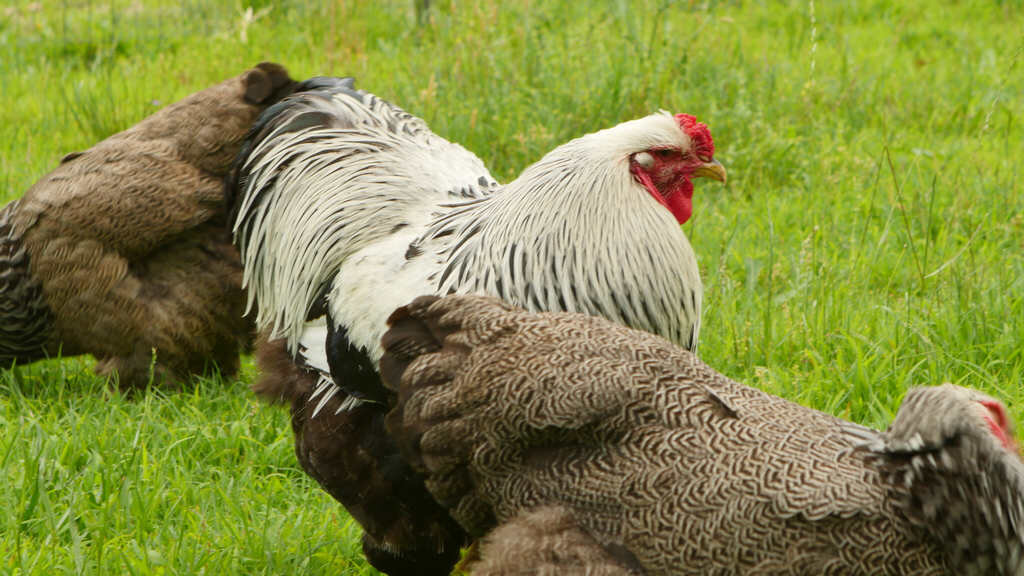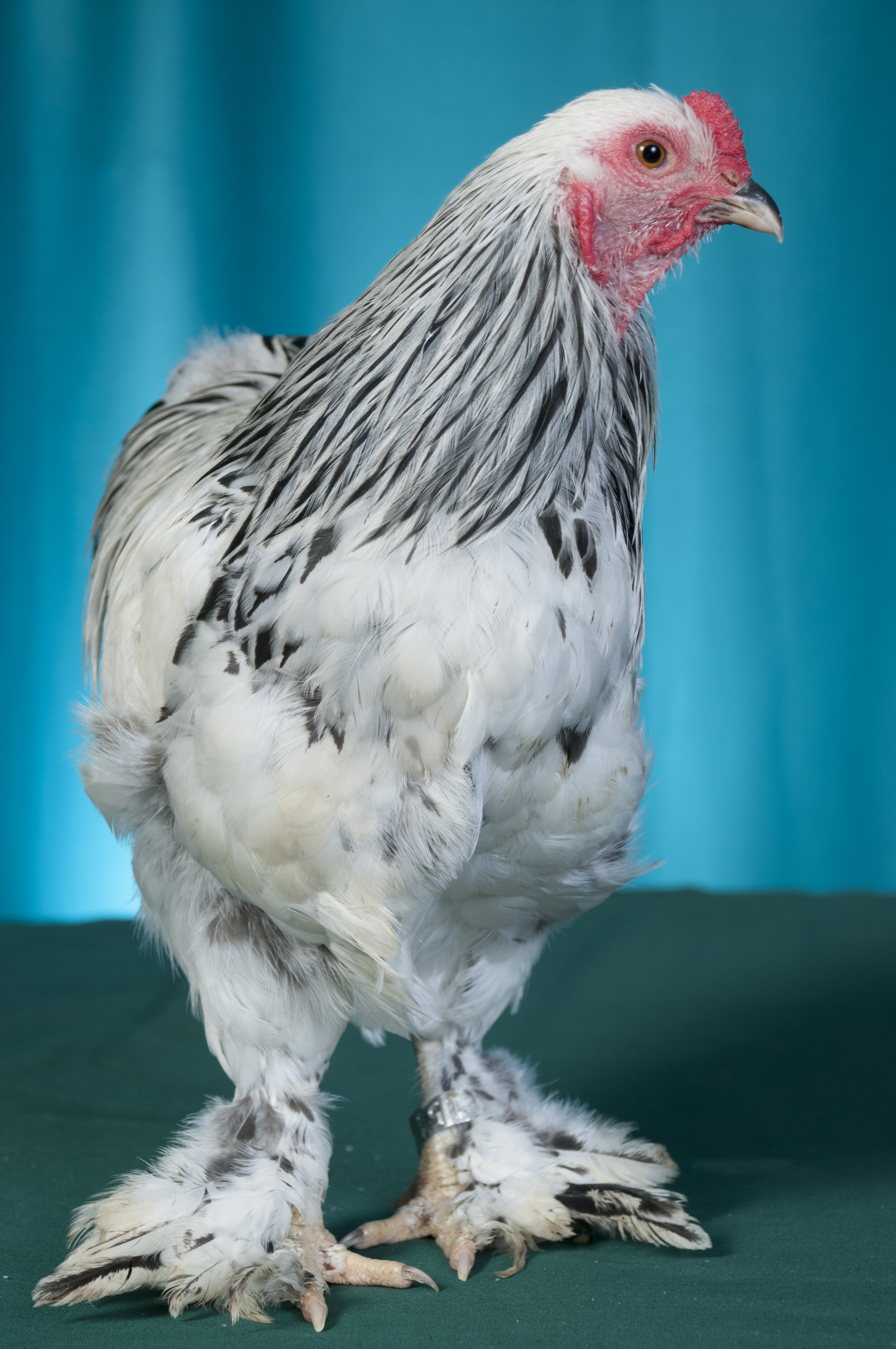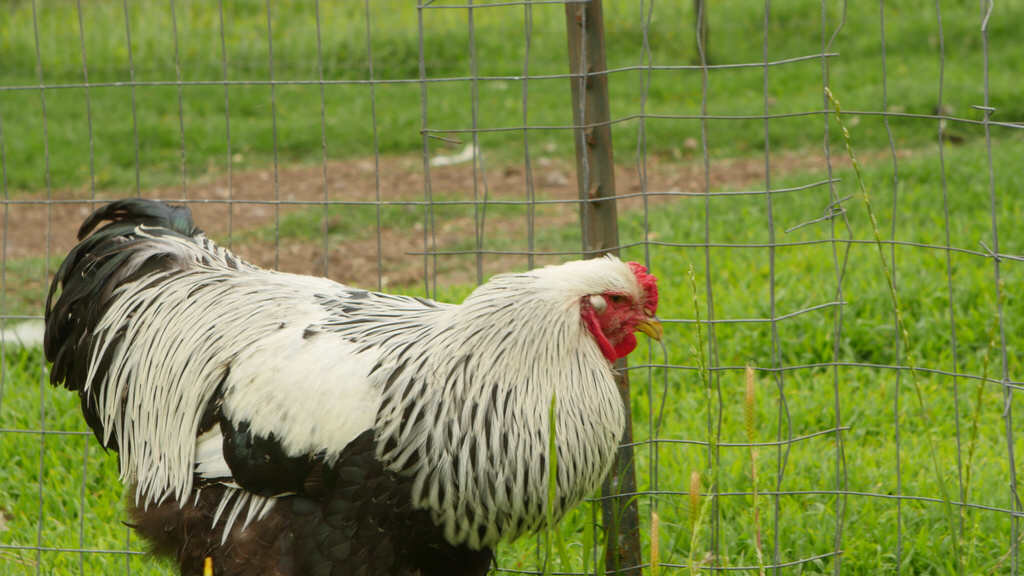Brahma
Dark Brahma
The Brahma (Asiatic class) is a heavy breed that was traditionally raised for meat production. They lay brown shelled eggs and have yellow skin. From reports in some of the earliest literature, this breed holds the record for the second-largest standard weights with mature birds as large as 18 pounds. They are recognized by the American Poultry Association (APA) in three varieties; Light, Dark, and Buff.
Standard Weights
Cock: 12 lbs.
Hen: 9.5 lbs.
Cockerel: 10 lbs.
Pullet: 8 lbs.
Overall, Brahmas are a large heavy boned breed with a pea comb and very small wattles with the females displaying a dewlap between the wattles. The heads of Brahmas are large and very broad with characteristic "beetle brows". The body is moderately long, wide, and very deep. The back is level with a moderate sweep up to the tail with the shanks and outer and middle toes being feathered.
This breed is most remarkable in that it was produced in India from a cross of Malay and Cochin and was almost immediately brought to America. Furthermore, the breed was developed and perfected in America and England while neglected in India, and given little attention in adjoining parts of China. It takes its name from the River Brahmaputra, a small stream in Assam, on the banks of which it is said to have originated. As a matter of fact, it was first called Brahma Pootra, but later shortened to Brahma. In its history, the Brahma has also been called Cochin China, Gray Shanghai, and Gray Chittagong.
Interest in the breed, and particularly in the birds with the "ermine" color (white with black points), began with the finding of several such birds on a vessel from Calcutta in New York harbor, in 1846 or 1847. In the same lot, there were also dark gray, red, and brown birds. At various times over the next five to seven years, other importations were received, the stock in all cases displayed indefinite patterns and mixed colors. It was claimed by those who obtained the "light" birds of the first importation that these bred absolutely true to type and color. But, the claim does not seem to be well-founded, according to the Brahma breeders who knew the stock in the 1850's reportedly none of the stock bred true to color. Both "light" and "dark" Brahmas were commonly obtained from "light" colored birds, and occasionally progeny of other colors were produced as well. The birds also had the pea comb of the Malay, the single comb of the Cochin, and any intermediate form. At first, the designation "Brahma" was applied only to "gray" birds. From the beginning, the pea comb was preferred, though as late as the early 1870s some strains still had a single comb. The Brahma was, from the beginning, regarded by many as more desirable than the other large Asiatic types, and the Light Brahma became the favorite in its class, a distinction which it has always retained. Brahmas in America have been bred with moderate foot feathering, which often in poorly bred strains is allowed to become very scanty, while in England they have been bred with much heavier plumage. In early times in America, efforts had been made to popularize modifications of the Brahma type in the form of scantily feathered and bare-legged strains, as well as undersized early-laying "utility" strains. Such efforts met with little encouragement, because large fowl Brahmas are, to most people, more attractive when at least moderately heavily feathered on the shanks and feet; and people who wanted smooth-legged fowls and early maturing fowls had a wide choice of other breeds.
The Brahma is very cold hardy and less susceptible to cold and exposure, surpassing the Cochin in this respect because of its pea comb. It is also, because of its shorter plumage, a little less affected by heat than the Cochin, though the differences in this respect are not great. In regard to temperament and broodiness, the Brahmas are as calm as the Cochin but not quite as prone to broodiness. It is not as prone to obesity as the Plymouth Rock and Wyandotte, and when managed for production, Brahmas are persistent layers, and are often either non-sitters or do not go broody until early summer.
Light Brahma
Light- recognized in 1874
The Light Brahma, as a variety, lays a large brown egg of a uniform medium brown color. In the early days, these qualities set them apart from the Dark Brahma and also from the Cochins. The Light Brahma color pattern was and is one of the most attractive color patterns. This gave it popularity as a market fowl, and this led growers to breed Brahmas to the larger and larger body weights. However, the Light Brahma as we know it today is very different from the original Light Brahma. The first Light Brahmas had white under color and less black striping in the saddle area of the male; the wings also had less black in them than they do today. Today the Light Brahma has black striping in the hackle with some black striping in the saddle of the male. The tail is black with the coverts being laced with white. The remainder of the birds' feathers is white with a gray under color. The flight feathers of the wings also have more black with only the leading edge of the feathers being white.
Light Brahma
However, over time the Light Brahma began to suffer in its popularity. This decrease in popularity began when a cock was placed first at a show in New York that had poor type but had excellent color. The publicity given to this bird without criticism of his shape led judges and breeders to give that type the preference over the correct type. The result was that in a few years it became the most common body shape and conformation. Unfortunately, this type was a clumsy, coarse boned, coarse meat type. The Light Brahma's numbers plummeted so low that by 1910 they were seldom seen at the shows where they were once numerous. At the time it was doubtful that they or any of the Asiatic breeds could be revived. The Brahma was rejected by market poultry-men who began to substitute extra-large Plymouth Rocks and Wyandottes. However, these did not meet requirements because the number of big Plymouth Rocks and Wyandotte's were too few. Then gradually the old type of Light Brahma came back, but the color was made more difficult to breed through the influence of breeders of the new Columbian Wyandottes and Plymouth Rocks.
Not only was the color pattern made more difficult to achieve, but by increasing the black pigment to get intensity of the color desired in the wing flight feathers the breeders brought so much black into the white sections that the peculiar beauty of the columbian pattern was lost in all but a small proportion of the best-bred specimens. This lead to the demise of the breed as grown for commercial production of meat, however, today it is a very popular show bird with many birds displaying excellent markings.
Dark Brahma
Dark- recognized in 1874
The Dark Brahma color pattern is synonymous with the Silver Penciled Wyandottes and Plymouth Rocks. The males have a silver hackle and saddle with the feathers being striped with black, with the wing bow and shoulders being solid silver. The tail, breast, and body are solid black. Females have a black hackle with slight penciling of gray and laced with white, while the back, breast, body, and wings are medium shade of gray intricately penciled with black. There should be three lines of black that conform to the shape of the feather. Clarity and sharpness of penciling are of the utmost importance.
The Dark Brahma was never used for commercial meat production to the extent that the Light Brahma had been utilized. The difficult color pattern was also harder to obtain through breeding and therefore smaller birds with excellent color patterns were selected as breeding stock. As a result, the Darks are, on average, smaller in body weight and frame than the Light variety. This difference in size was so much, and by the prompting of Light Brahma breeders, in 1883 the standard requirements were revised to set the weights of Light Brahmas a pound heavier than the target weights for Dark Brahmas. But eventually, these higher weights were also adopted for the Dark.
Dark Brahmas, with the breed shape and character of the Light Brahma, are not as common. Until the Silver Penciled Wyandottes and Plymouth Rocks were developed, the Dark Brahma was the only breed of chicken with the "silver penciled" color pattern, and consequently was a favorite with fanciers of that color. The difficulty of breeding the pattern limited its popularity, yet small flocks of Dark Brahmas were quite numerous until other breeds of the same variety were emphasized, then interest in Dark Brahmas declined.
However, the Dark Brahma, as a breed, did experience a resurgence in interest. It had become apparent that silver penciled varieties in the American class would remain a 'fanciers fowl', and those breeders who worked with them with the expectation that they would become popular and commercially profitable realized they were mistaken. This led to a considerable revival of interest in the Dark Brahma, because the triple penciled pattern can be more easily obtained on large birds with broad feathers.
Dark Brahmas were generally considered better layers than the Lights, the difference was the result of the Darks not being selected as heavily for flesh quality. However, today there is no appreciable difference between the two.
Buff- recognized in 1924
This variety was admitted to the standard in 1924. The color pattern is the same as the Light Brahma, only with buff taking place of the white-feathered areas. This color pattern is not a new one and has been present in a crude form in crossbred and mongrel birds, especially where Light Brahmas and Buff and Partridge Cochins had been used. There had been frequent attempts prior to 1924 to recognize the Buff; however early applications were always rejected. When the buff was first admitted a few birds of good quality existed. Today, it has become a very attractive variety with excellent specimens being produced. However, the Buff is still not as common as the Light.
Buff Brahma Bantam
Bantam Brahmas
Both the American Bantam Association (ABA) and APA recognize a bantam Brahma (feather legged class). Brahma bantams are one of the most popular breeds of bantam chickens today and are frequent winners of the feather legged class. The type and color requirements are the same as for large Brahmas. The Light Brahma was admitted to the ABA Standard of Perfection in 1898, with the Darks being admitted in 1895, and Buff in 1945. In addition to the Buff, Dark, and Light the ABA also recognizes the Black and White Brahma, though they are not seen very often.
Standard Weights
Cock: 38 oz.
Hen: 34 oz.
Cockerel: 34 oz.
Pullet: 30 oz.
Prepared by Michael Schlumbohm and Keith Bramwell, Department of Poultry Science, University of Arkansas, Fayetteville, Arkansas.
Works Cited
Robinson, John H. Popular Breeds of Domestic Poultry. Dayton: Reliable Poultry Journal, 1924.
Brown, Edward. Races of Domestic Poultry. Liss: Nimrod Book Services, 1985.
The American Standard of Perfection Illustrated: A Complete Description of All Recognized Breeds and Varieties of Domestic Poultry. Burgettstown, PA: American Poultry Association, 2010.
Bantam Standard for the Breeder, Exhibitor, and Judge. 2011 ed. Kansas City: Covington Group, 2011.






